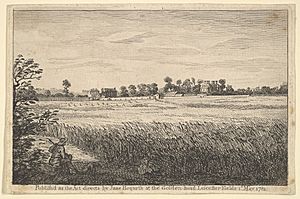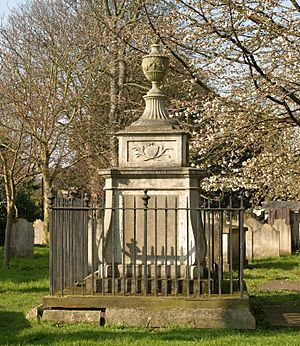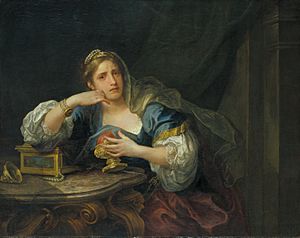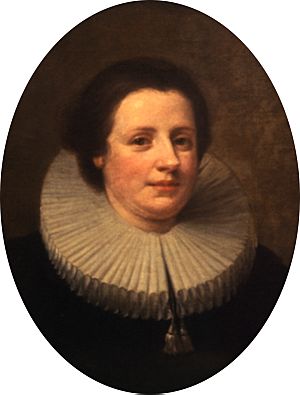Jane Hogarth facts for kids
Quick facts for kids
Jane Hogarth
|
|
|---|---|
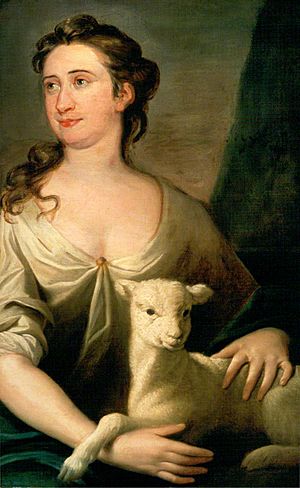
Jane Hogarth, portrait by William Hogarth
|
|
| Born | c. 1709 |
| Died | 13 November 1789 Chiswick, England, Kingdom of Great Britain
|
| Nationality | British |
| Spouse(s) | William Hogarth |
| Parent(s) |
|
Jane Hogarth (born around 1709 – died 1789) was a smart British businesswoman. She sold prints and artwork. After her husband, William Hogarth, a famous artist, passed away, Jane made sure his art and his rights to it were protected. She successfully kept selling his amazing works for many years.
Contents
Jane's Early Life and Marriage
Jane was born Jane Thornhill around 1709. Her father, James Thornhill, was a well-known painter. In 1729, Jane married William Hogarth in Paddington. They married without her father's permission.
By 1731, William moved into Jane's home in London's Covent Garden. As William Hogarth became more successful, they bought a second house in Chiswick. Many important thinkers and performers lived there. Jane and William did not have children of their own. However, they supported Thomas Coram's Foundling Hospital, which cared for abandoned children.
In 1760, William Hogarth became ill. He moved back to their Covent Garden house, while Jane stayed in Chiswick. William died in 1764. In his will, he left his print business to Jane.
Running the Business as a Widow
Jane Hogarth lived 25 years after her husband, William, passed away. She continued to sell his artwork. Jane also protected his good name and kept all his important papers.
She had a special agreement about William's copperplates (the metal plates used to make prints). She could not sell them without permission from William's sister, Anne Hogarth. Jane also paid Anne a yearly amount from the money she made selling prints.
Jane started publishing new versions of the engravings in 1765. To make sure her rights lasted longer, she went to the British Parliament in 1767.
Protecting Copyrights
The legal protection for William Hogarth's older works was about to end. This protection came from the Engraving Copyright Act 1734. Jane Hogarth worked hard to get new legal rights for her husband's original copyrights.
On June 29, 1767, a new law was passed. This law extended her rights from 14 years to 20 years. It gave her "the sole right and liberty of printing and reprinting all the said prints, etchings, and engravings, of the design and invention of the said William Hogarth, for and during the term of twenty years." This meant only she could print and sell his works for two more decades.
Publishing and Challenges
Jane Hogarth produced and advertised prints as real works by William Hogarth. She often highlighted the moral lessons in his art. Many stories and comments about Hogarth's work came from a French artist named Jean André Rouquet. He wrote Lettres in 1746.
Jane Hogarth also worked with Reverend John Trusler. Together, they published a book called Hogarth Moralized in 1768. This book explained the meanings behind Hogarth's art.
Another printer, Robert Sayer, also had many copies of William Hogarth's plates. He sold prints at lower prices than Jane Hogarth. This made things harder for her business.
Jane also expanded her business. She worked with artist John Keyse Sherwin. In 1774, they published The Politician. This was an engraving based on a sketch William Hogarth made for his friend, Ebenezer Forrest. It was later included with her husband's other prints.
Jane also worked with Richard Livesay. They had a painting by William Hogarth turned into a print by Francesco Bartolozzi. It was sold as Shrimps!.
Eventually, the value of the prints went down. The Royal Academy of Arts then gave Jane Hogarth a pension. This helped her financially.
Death and Legacy
Jane Hogarth passed away on November 13, 1789, in Chiswick.
Her property and business rights went to her cousin, Mary Lewis. Mary then sold the rights to William Hogarth's copper plates to John Boydell. She received a yearly payment for them.
Many of the remaining Hogarth collections were put up for sale. This included the painting Sigismunda mourning over the Heart of Guiscardo and works by James Thornhill. John Greenwood was the auctioneer on April 24, 1790.
John Ireland bought papers from Mary Lewis. This led to his important books, Hogarth Illustrated (1791) and A Supplement to Hogarth Illustrated (1798).
Today, the house in Chiswick where William and Jane Hogarth lived is a museum.
Mary Lewis's Role
Mary Lewis was Jane Hogarth's companion and first cousin. She was also part of the Hogarth household and mentioned in William Hogarth's will. Mary was involved in the print business with Jane and Anne Hogarth starting in 1764.
Mary was the daughter of David Lewis, who was a harp player for King George II. She passed away in 1808. The rest of the Hogarth collections then went to her cousin, Philip Francis Hast. Eventually, in 1939, they were given to the Aberdeen Art Gallery.


